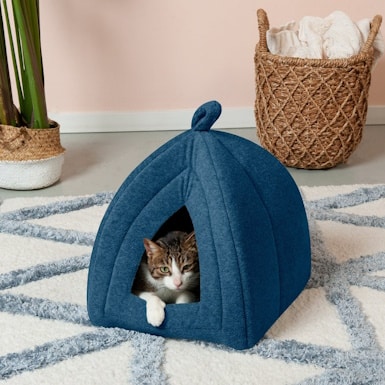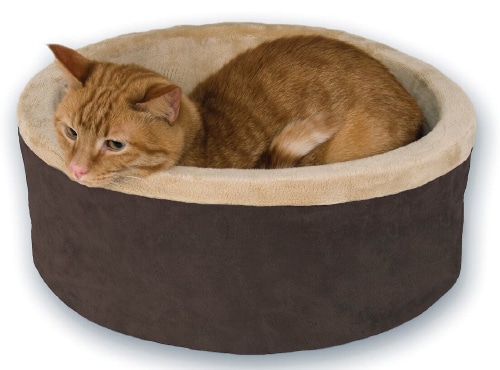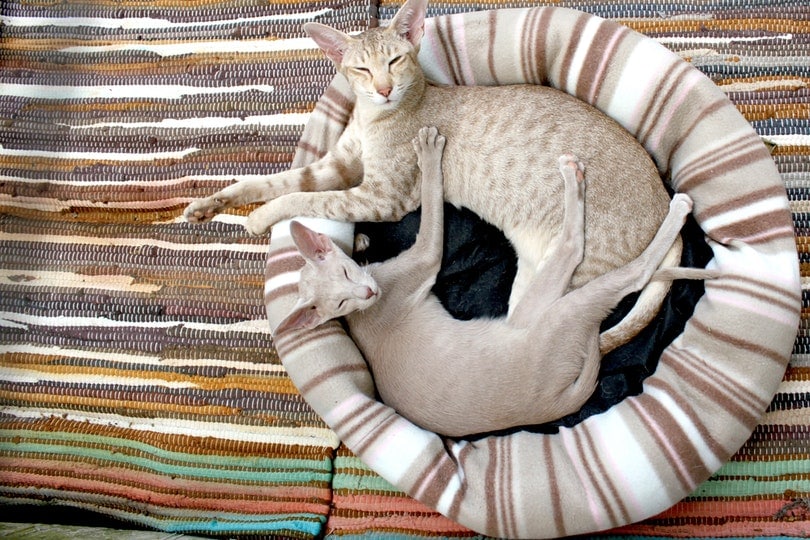
Because older cats slow down a bit, many spend lots of time napping, which makes a good cat bed essential. If you’re searching for the perfect cat bed for your senior companion, you’re in luck. We’ve compiled detailed reviews of the 10 best cat beds for older cats below.
A Glance at Our Favorites in 2024
| Image | Product | Details | ||
|---|---|---|---|---|
| Best Overall |

|
Best Friends by Sheri Original |
|
CHECK PRICE |
| Best Value |

|
Downtown Pet Supply Thermal Cat Mat |
|
CHECK PRICE |
| Premium Choice |

|
Hepper Nest Bed |
|
CHECK PRICE |

|
Frisco Sherpa Orthopedic Bolster Bed |
|
CHECK PRICE | |

|
Mr. Peanut's OrthoPlush Orthopedic |
|
CHECK PRICE |
The 10 Best Cat Beds for Older Cats
1. Best Friends by Sheri Original Calming Shag Fur Donut Cuddler Cat Bed

| Size: | 23” L x 23” W x 7” H |
| Type: | Bolster |
The adorably snuggly Best Friends by Sheri Original Calming Shag Fur Donut Cuddler Cat Bed is the best overall cat bed for older cats and features ample cushioning to help support senior pets’ achy joints. It’s an excellent choice for cats that enjoy sleeping curled up and could benefit from a bit of extra cushioning. It’s covered in shag fur to keep your cat nice and toasty when temperatures drop.
It’s machine washable, so you can quickly clean up accidents. It even has a water-resistant bottom to help protect your floors if your buddy can’t make it to the bathroom on time. It’s available in multiple sizes, so options are available for cats of all weights. The small bed can hold cats who weigh up to 25 pounds, and you can choose from several colors, including frost, dusty rose, lavender, and gray.
- Water-resistant bottom
- Machine washable
- Available in multiple sizes
- Can only be washed on cold
2. Downtown Pet Supply Thermal Leopard Print Cat Mat

| Size: | 22” L x 19” W x 0.5” H |
| Type: | Pillow |
The Downtown Pet Supply Thermal Cat Mat is the best cat bed for senior cats for the money. It’s a simple self-heating bed that doesn’t require cats to climb into or out of anything. The product has a Mylar center that reflects heat back to cats and doesn’t need to be plugged in. It weighs almost nothing, so it’s easy to move if your cat suddenly decides they’d prefer to nap in your kitchen instead of your living room.
It’s machine washable but can only be cleaned in cold water, so you may want to throw a cotton sheet or towel you can launder at high temperatures over the bed to make it easier to keep your pet’s sleeping area as clean as possible. While it’s a great option if you’re looking for a simple way to help your cat stay warm, it’s not terribly thick, so it doesn’t provide much cushioning.
- Machine washable
- Lightweight and easy to move
- Self-warming
- Not enough cushioning
3. Hepper Nest Cat Bed – Premium Choice

| Size: | 17.5” L x 17.5” W x 5.75” H |
| Type: | Bowl |
The Hepper Nest Bed is a comfortable bowl option that’s just right for cats who like to curl up when napping. The bowl is made of molded foam to give it a soft, warm feel. It features a cozy fleece liner to keep cats nice and toasty that’s easy to remove and can even be thrown in the washing machine when it gets dirty.
The molded foam shell, however, needs to be spot-cleaned. It’s large enough to hold cats weighing up to 17 pounds, making it a great choice for larger cats. It’s lightweight, so it’s easy to move from place to place if your cat enjoys trying out different napping spots.
At Catster, we’ve admired Hepper for many years and decided to take a controlling ownership interest so we could benefit from the outstanding designs of this cool cat company!
- Ideal for larger cats
- Machine washable fleece liner
- Lightweight and easy to move
- Shell can only be spot-cleaned
4. Frisco Sherpa Orthopedic Bolster Cat Bed

| Size: | 24” L x 18” W x 6” H |
| Type: | Bolster |
The Hepper Nest Bed features supportive memory foam that provides a soft place for your cat to nap. The cozy bolster bed has a removable cushion packed with soft polyester filling. One side of the pillow has a fluffy fleece cover, and the other has an attractive print.
You can remove the cover from the pillow and the base, and both can be thrown in the washing machine. It’s available in multiple sizes, and finding a bed that works well with your pet’s lounging style is easy. Unfortunately, it’s not water-resistant, so it may not be the best choice for accident-prone cats.
- Memory foam for comfort
- Removable double-sided cushion
- Removable, machine-washable pillow and base covers
- Not water-resistant
5. Mr. Peanut’s OrthoPlush Orthopedic Cat Bed

| Size: | 23” L x 23” W x 6” H |
| Type: | Donut |
Mr. Peanut’s OrthoPlush Orthopedic Cat Bed is designed to give cats with joint and mobility issues a comfy, soft spot to rest comfortably. It has a relatively flat center surrounded by a slightly raised edge that cats can snuggle up against. The entire bed is made of PP cotton, which is a soft man-made product that’s great for cat beds since it’s soft and easy to keep clean. While the Mr. Peanut’s bed features several inches of cushioning to help relieve pressure on your cat’s joints, it’s not made of memory foam.
- Machine washable
- Slightly raised bolster edge
- PP cotton filling for softness
- Doesn’t feature memory foam
6. Ethical Pet Sleep Zone Cuddle Cave Cat Bed

| Size: | 9” L x 9” W x 0.25” H |
| Type: | Cave |
The Ethical Pet Cuddle Cave is ideal for older cats who love to snuggle in blankets. It features a soft, attractive micro suede exterior. Luxurious faux fur lines the inside of the cave to keep your cat nice and warm. Resilient poly-fill stuffing ensures the cave keeps its shape over time. And you can even recycle the filling when it’s time for a new cat bed!
It comes in three subtle colors: tan, sage, and chocolate. The cave is machine washable, but you can’t put it in the dryer, so expect your cat to be without a napping place for a day or so while waiting for the bed to dry after washing it.
- Soft microsuede exterior
- Snuggly faux fur interior
- Available in three colors
- Air dry only
7. FurHaven Calming Fleece Covered Cat Bed

| Size: | 13” L x 13” W x 16” H |
| Type: | Tent |
This adorable fleece tent gives older cats a warm, enclosed place to while away the hours, and there’s even a soft removable fleece cushion for kitties to curl up on. The front of the tent has a relatively low entrance, and the bed may not be easily accessible for cats with severe mobility limitations.
However, it’s easy to keep clean, and the tent and cushion are machine washable. It’s incredibly lightweight, so you can move it around if your cat decides to change their napping locations. It comes in various colors, including blue, beige, pink, and gray.
- Cozy enclosed option
- Soft, warm fleece material
- Removable cushion
- May not be easily accessible for cats with mobility problems
8. K&H Pet Products Thermo-Kitty Bed Indoor Heated Cat Bed

| Size: | 16” L x 16” W x 6” H |
| Type: | Bolster |
Plug-in heated cat beds provide continual enveloping warmth to keep senior cats warm and ease painful, achy joints. The round bolster of K&H Pet Products Thermo-Kitty Bed Indoor Heated Cat Bed features a soft orthopedic foam base and a removable heating pad. The heating pad is designed to warm up to match your pet’s temperature when your cat lies in bed.
The temperature drops to about 10 to 15º F above room temperature when your cat isn’t hanging out in the bolster. The stylish bed even has a 5 ½-foot power cord, giving you flexibility regarding where you place it. The cover and cushion are machine washable to make cleaning up after older pets a breeze. You can choose from two sizes to find the right fit for your cat. However, there’s no off switch, and the only way to turn off the heating pad is to unplug it.
- Supportive orthopedic foam
- Machine washable
- Warms when your cat is in bed
- No on/off switch
9. Pet Magasin Self-Warming Cat Cave

| Size: | 22” L x 17” W x 17” H |
| Type: | Cave |
The Pet Magasin Cat Cave provides kitties with a snuggly place to relax and a little privacy. It can be set up in four configurations: a cave, an upright hideaway, a pod, or a pillow. It has a soft fleece and antimicrobial microfiber exterior and a soft, lined interior for cats to curl up. It’s machine washable, but make sure to use cold water and allow plenty of time for the cave to air dry. A Mylar interior layer absorbs heat from your cat’s body and reflects it to provide a steady source of warmth. It’s a good choice if you’re looking for a warming option that doesn’t need to be turned off or unplugged.
- Multiple configurations
- Antimicrobial microfiber
- Self-heating option
- Not water resistant
10. MidWest QuietTime Defender Orthopedic Bolster Cat Bed With Removable Cover

| Size: | 28” L x 22.5” W x 8.25” H |
| Type: | Bolster |
Bolster beds with at least one lowered side are ideal for older cats with mobility limitations, and they’re usually easier to get into and out of than models with higher edges. The Quiet Time Defender Bolster Bed features an orthopedic foam base to support aging kitties’ joints, and it even comes with an easy-to-remove cover.
The cover is designed to be odor, stain, and water-resistant, and you can put it in the washing machine if things get messy. Unfortunately, spot cleaning is the only option for removing stains from the base. The bed comes in multiple sizes, including 22-inch beds appropriate for pets weighing up to 12 pounds and 28-inch options that can handle kitties weighing as much as 25 pounds.
- Machine washable cover
- Water-resistant cover
- Available in multiple sizes
- The foam base isn’t machine washable
Buyer’s Guide: Selecting the Best Cat Beds for Older Cats
While selecting the right choice for your cat may seem difficult given the number of options available, there are a few factors you can focus on to help narrow things down, including your cat’s needs and lounging preferences, product size, heating options, and washability.

Your Cat’s Needs
Before you get started searching for cat beds, spend some time thinking through and identifying your cat’s precise needs; it’ll make it easier to identify appropriate options. Older cats that may be losing weight may benefit from a nice heated bed to help them stay warm.
Senior cats suffering from mobility issues may need several easy-to-enter beds placed around the house so they don’t have far to walk to find somewhere comfortable to rest. And pets with painful joint conditions may benefit from a product featuring supportive foam to help them become comfortable when lying down. Cats that have trouble making it to the bathroom on time are usually better off with waterproof and easily washable beds.
Shape
Most cats have lounging preferences; some prefer to nap spread out, and others like to curl up as tightly as possible. Kitties that prefer to sleep curled up sometimes like beds with bolstered edges to curl up against, and covered tents give privacy-seeking pets somewhere to catch some sleep.
Heating Options
As cats age, they often lose weight, and many have trouble staying warm even in normal indoor temperatures. Pets with arthritis and other joint conditions often feel better with a little extra heat, and you can purchase heated pillows, bolsters, and covered beds appropriate for older cats. There are three general categories of heated beds: self-heated beds, microwavable beds, and electronic products.

Self-Heating Products
Self-heating beds feature products such as Mylar to keep your cat nice and cozy, so they don’t need to be plugged in. They’re typically quite safe and are good options if you’re looking for a way to give your cat a nice warm place to cuddle while you’re away from home. They’re also good choices for homes with cats, kittens, dogs, or puppies who chew on cords.
Microwavable Products
Microwaveable products aren’t cat beds but are cushions or pads filled with gel, rice, or something similar that retains heat over time. They’re designed to be heated in the microwave and placed in your pet’s bed to warm things up. Microwavable inserts cool down over time, and they’re not great choices if you’re looking for a way to provide your pet with sustained warmth while you’re at work. Also, it can sometimes be a bit tricky to get the temperature just right.
Electronic Products
Plug-in beds provide sustained heat to keep pets nice and toasty; think of them as fancy electric blankets or heating pads for cats. Look for brands specifically designed for pets, which generally match your pet’s body temperature to prevent burns. Some even turn themselves down automatically when your pet isn’t using the product. Many feature timing programs so you can set things up to automatically turn off after a certain time. Beds with automatic shut-off features provide an extra layer of safety just in case you forget to unplug them before leaving the house.

Washability
Washability is a significant factor when selecting cat beds for older cats; senior pets have more accidents than younger cats for various reasons, so it’s crucial to be able to quickly and thoroughly clean your buddy’s favorite bed. Brands with covers you can wash at high temperatures are easy to clean when cats throw up or leave runny feces in their bed. FYI —
Also, you can add a soft, folded cotton sheet, blanket, or towel to your cat’s bed to make laundry day a bit easier. It’ll collect most of the germs and dirt and can usually be washed at high temperatures.
Waterproofing
Cat beds with waterproof covers can help keep accidents from seeping into your pet’s bed and making a mess of the cushion. Several beds with memory foam come with removable covers you can throw in the washing machine.
Cushioning
Bolsters and pillow beds often provide thick cushioning and are often good options for cats recovering from illness or having trouble getting around. Products featuring memory foam provide comfort and support for cats with painful joints.

Size
Several brands are available in multiple sizes, making it easy to order a choice that’s just right for your cat. A small cat that likes to sleep curled up may do just fine with the recommended bed size, but a slightly larger kitty that likes to have bolster support while spreading out may do better with a larger model.
Entry Options
Beds that are easy to get in and out of are essential for older cats since mobility problems are relatively common in senior pets. Pillow beds that don’t have sides are the easiest designs for cats to access. It’s possible to find bolsters with one side lowered to make it easy for cats with sore joints to get into and out of bed.
Other Considerations
Don’t be afraid to consider products marketed for dogs, particularly if you have a large older cat that needs a warm heated place to sprawl on the floor. It’s often possible to find high-quality dog beds that hit all the high notes you’re likely looking for in a cat bed.
Give your cat time to accept their new bed. Kitties are notorious for taking their sweet time when it comes to interacting with new things in their environment. Unpack your pet’s new bed and allow them to investigate things on their own. A few sprinkles of catnip or silvervine can often motivate cats to spend more time exploring their new beds. A few treats tucked into the bed may also help move things along.

Conclusion
While there are several fantastic brands to choose from when it comes to cat beds for senior pets, a few hit all the high notes, according to our reviews. The Best Friends by Sheri Original Calming Shag Fur Donut Cuddler Cat Bed is a great option that gives pets lots of comforting support to snuggle into. The Downtown Pet Supply Thermal Leopard Print Cat Mat is a simple self-heating model that your buddy can enjoy even if you’re not around since it doesn’t need to be plugged in to work. Our premium pick, the Hepper Cat Nest, gives cats that like to sleep curled up a warm, supportive place to nap.
Featured Image Credit: Iva Vagnerova, Shutterstock
Contents
- A Glance at Our Favorites in 2024
- The 10 Best Cat Beds for Older Cats
- 1. Best Friends by Sheri Original Calming Shag Fur Donut Cuddler Cat Bed
- 2. Downtown Pet Supply Thermal Leopard Print Cat Mat
- 3. Hepper Nest Cat Bed – Premium Choice
- 4. Frisco Sherpa Orthopedic Bolster Cat Bed
- 5. Mr. Peanut’s OrthoPlush Orthopedic Cat Bed
- 6. Ethical Pet Sleep Zone Cuddle Cave Cat Bed
- 7. FurHaven Calming Fleece Covered Cat Bed
- 8. K&H Pet Products Thermo-Kitty Bed Indoor Heated Cat Bed
- 9. Pet Magasin Self-Warming Cat Cave
- 10. MidWest QuietTime Defender Orthopedic Bolster Cat Bed With Removable Cover
- Buyer’s Guide: Selecting the Best Cat Beds for Older Cats
- Your Cat’s Needs
- Shape
- Heating Options
- Self-Heating Products
- Microwavable Products
- Electronic Products
- Washability
- Waterproofing
- Cushioning
- Size
- Entry Options
- Other Considerations
- Conclusion












